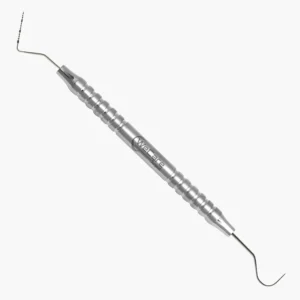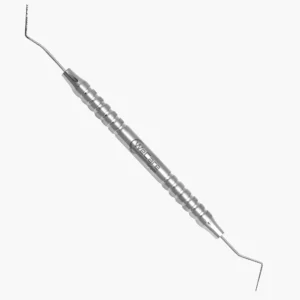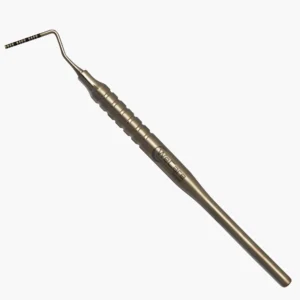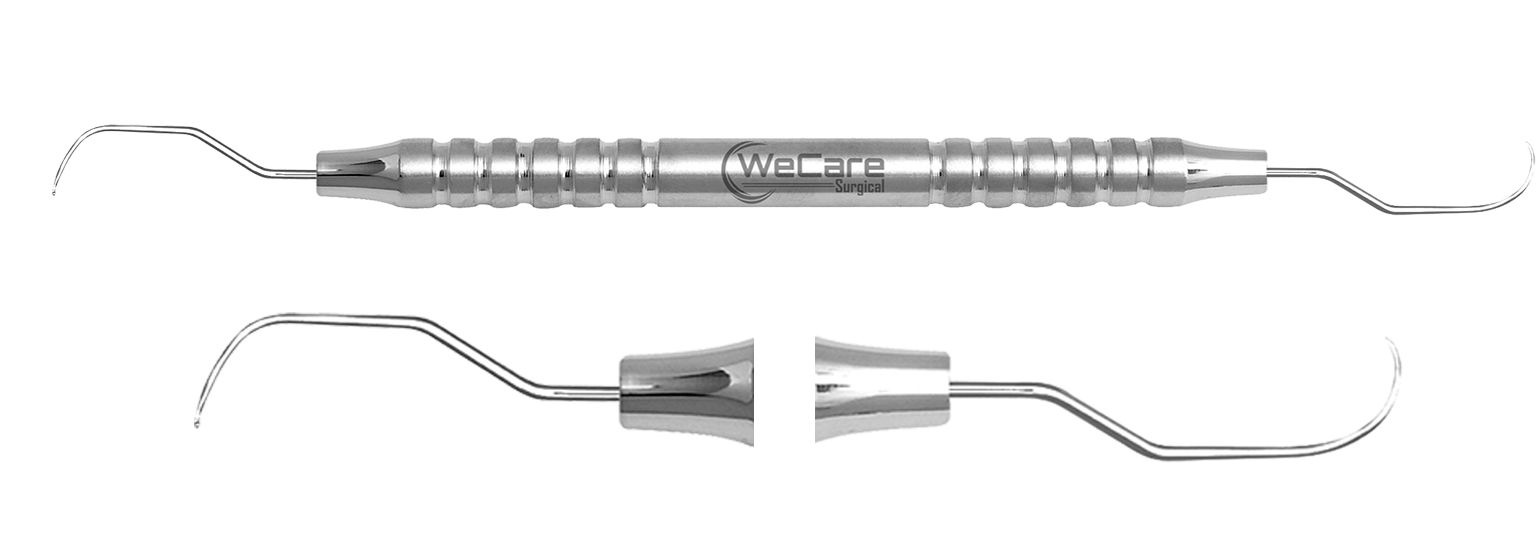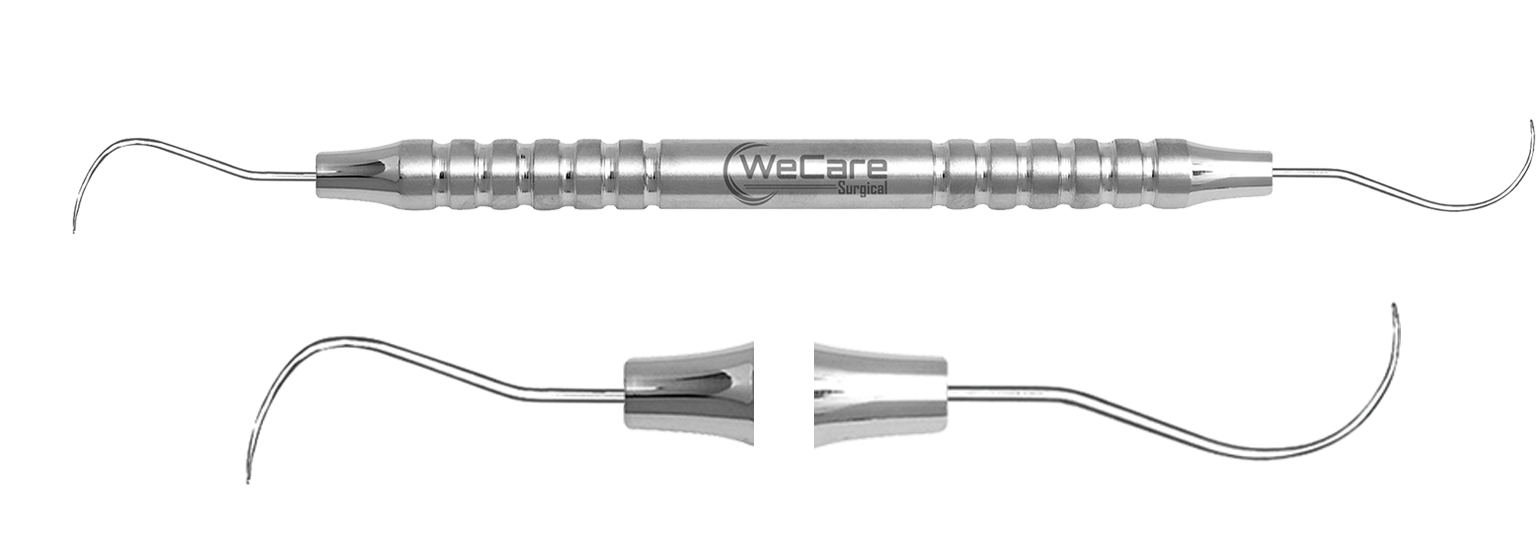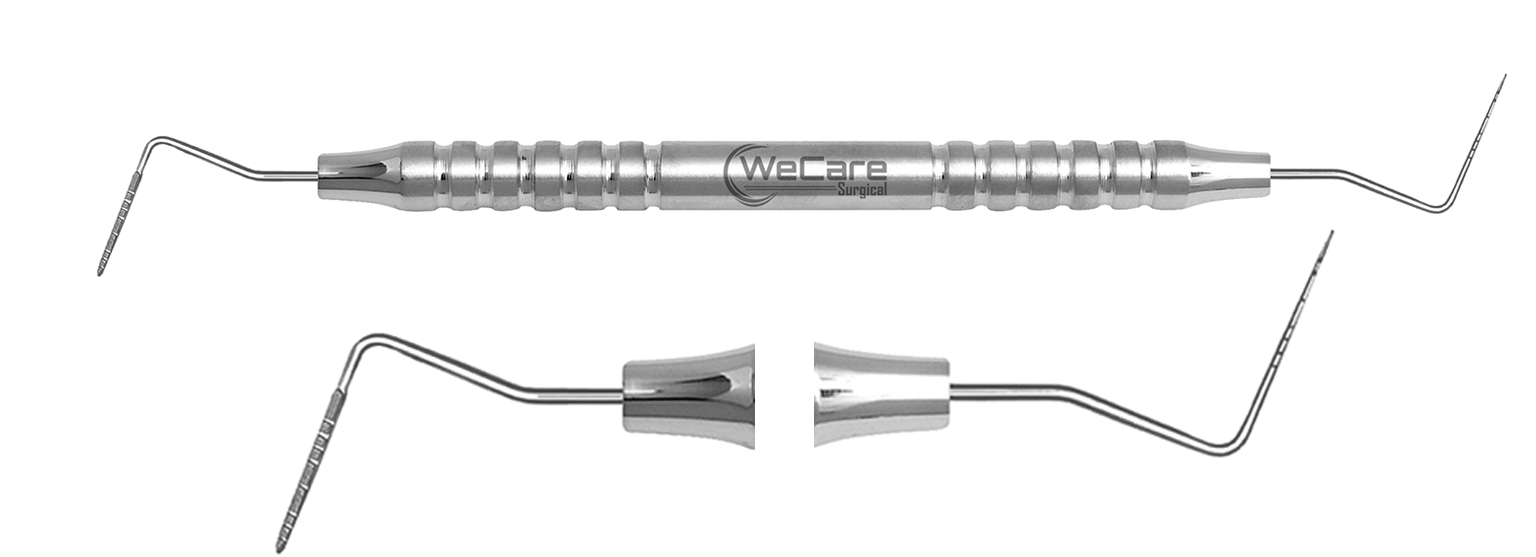Dental Furcation Probe
wecare surgical2025-11-05T07:23:05+00:00Furcation Probe
Precision Tool for Root Involvement Detection


A furcation defect refers to bone loss that occurs where the roots of a multirooted tooth divide — most commonly in molars and upper premolars.
This condition often develops as a result of periodontal disease, leading to tooth instability, plaque accumulation, and difficulty in maintaining oral hygiene.
Early detection of furcation defects is crucial for preventing tooth loss and guiding effective periodontal treatment.
At WeCare Surgical, our Nabers Probes are manufactured with surgical-grade AISI 420 stainless steel, offering exceptional accuracy, durability, and tactile sensitivity — trusted by periodontists and hygienists worldwide.
What Is a Furcation Probe?
A Furcation Probe, also known as a Nabers Probe, is a specialized periodontal instrument used to detect and measure furcation involvement — the bone loss between the roots of teeth.
It allows clinicians to determine the extent and severity of bone loss and plan treatment with precision.
Clinical Use and Application
Furcation probes are essential diagnostic tools used in:
- Identifying furcation involvement along with radiographs and CBCT scans
- Treatment planning in root resection, scaling, and regenerative procedures
- Monitoring outcomes of periodontal therapy
By integrating furcation measurements with clinical findings, WeCare Surgical Probes ensure precision and confidence in every periodontal assessment.
Product Highlights
- Made from AISI 420 stainless steel
- Laser-engraved markings for precise readings
- Ball-ended tip minimizes tissue trauma
- Autoclavable and corrosion-resistant
- Ergonomic grip ensures maximum comfort during use
- Available in Nabers 1N–4N models
How the Furcation Probe Is Used
The Nabers Probe is used by dental professionals to measure both horizontal and vertical bone loss in furcation areas — the spaces between the roots of multi-rooted teeth.
It is primarily applied in:
- Molars and upper premolars (teeth with multiple roots)
- Clinical assessments of bone loss and periodontal pocket depth
Laser-engraved millimeter markings ensure consistent and reliable readings, enabling clinicians to classify furcation involvement accurately using Glickman or Hamp classification systems.
For a step-by-step demonstration of how to properly use a Furcation Probe in clinical settings, watch this short video guide:
> How to Use a Furcation Probe – Clinical Demonstration
Trending Products
-
Dental Probes, Periodontal Probe, Williams Periodontal Probe
Dental Periodontal Probe Williams Explorer 23 Double Ended Diagnostic Instrument
0 out of 512.50 $Original price was: 12.50 $.9.25 $Current price is: 9.25 $. -
Dental Probes, Periodontal Probe, WHO Probe
Double-Ended #23 Explorer + 3-6-9-12 WHO Probe (AISI 420 Stainless Steel)
0 out of 512.50 $Original price was: 12.50 $.9.25 $Current price is: 9.25 $. -
Dental Probes, Periodontal Probe, Williams Periodontal Probe
Double-Ended Goldman Fox Williams Probe / #23 Explorer (AISI 420 Stainless Steel)
0 out of 512.50 $Original price was: 12.50 $.9.25 $Current price is: 9.25 $. -
Dental Probes, Periodontal Probe, UNC Periodontal Probe
UNC-15 Periodontal Probe – Single Ended | AISI 420 Stainless Steel
0 out of 512.50 $Original price was: 12.50 $.8.75 $Current price is: 8.75 $.
Furcation Involvement Classifications (Simplified)
Glickman Classification (1953)
Class I
The concavity, just above the furcation entrance, on the root trunk can be felt with the probe tip; however, the furcation probe cannot enter the furcation area.
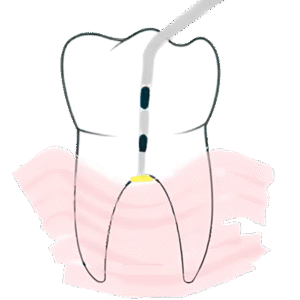

Class II
The probe is able to partially enter the furcation, extending approximately one third of the width of the tooth, but it is not able to pass completely through the furcation.
Class II
The probe is able to partially enter the furcation, extending approximately one third of the width of the tooth, but it is not able to pass completely through the furcation.

Class III
In mandibular molars, the probe passes completely through the furcation between the mesial and distal roots.
In maxillary molars, the probe passes between the mesiobuccal and distobuccal roots and touches the palatal root.
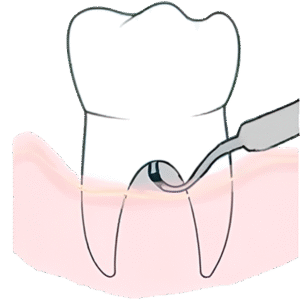
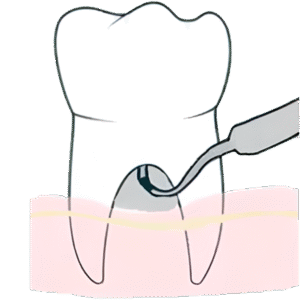
Class IV
Same as a class III furcation involvement except that the entrance to the furcation is visible clinically owing to tissue recession.
Class IV
Same as a class III furcation involvement except that the entrance to the furcation is visible clinically owing to tissue recession.

Hamp Classification (1975)
Class I
This stage shows mild horizontal bone loss of less than 3 mm. The defect is limited and does not pass through the bone. Clinically, it appears as an early furcation involvement with minimal tissue damage. Early treatment can usually stop further progression.


Class II
Here, bone loss is greater than 3 mm but not through-and-through. The furcation defect is partially advanced, with some bone still intact. It indicates moderate periodontal involvement. Surgical care and good maintenance are often needed to control the disease.
Class II
Here, bone loss is greater than 3 mm but not through-and-through. The furcation defect is partially advanced, with some bone still intact. It indicates moderate periodontal involvement. Surgical care and good maintenance are often needed to control the disease.

Class III
This class shows complete through-and-through bone loss between the roots. The furcation is fully open from one side to the other. It reflects severe periodontal destruction and loss of attachment. Treatment usually requires advanced surgical procedures.

Types of Furcation Probes
The WeCare Surgical Nabers Probe Series includes four precision-calibrated models, each designed for accurate detection of furcation involvement in multi-rooted teeth.
All probes are made from AISI 420 surgical-grade stainless steel, with laser-engraved millimeter markings (1 mm to 10 mm) for consistent measurement and ergonomic, non-slip handles for clinical comfort.
Laser-engraved millimeter markings (1 mm to 10 mm or up to 15 mm)
Ball-ended tips for minimal tissue trauma
Ergonomic, non-slip handles for clinical comfort
CE & ISO-certified construction, fully autoclavable
Nabers 1N – Straight Tip (Mandibular Molars)
Features:
- Straight working end with markings at 3, 6, 9, and 12 mm
- Ideal for detecting early furcation involvement in mandibular molars
- Provides excellent linear control for accurate probing
Easy to clean and maintain during lower molar procedures
Nabers 2N – Curved Tip (Maxillary Molars)
Features:
- Moderate curvature for easy access to maxillary molars
- Clear markings at 3, 6, 9, and 12 mm
- Allows gentle entry into bifurcation and trifurcation areas
- Minimizes soft tissue trauma while maintaining diagnostic precision
Nabers 2N – Curved Tip (Maxillary Molars)
Features:
- Moderate curvature for easy access to maxillary molars
- Clear markings at 3, 6, 9, and 12 mm
- Allows gentle entry into bifurcation and trifurcation areas
- Minimizes soft tissue trauma while maintaining diagnostic precision
Nabers 3N – Deep Curvature (Advanced Detection)
Features:
- Deeper curved tip with extended 15 mm scale
- Enables access to advanced furcation lesions and deep periodontal pockets
- Ideal for evaluating Grade II–III furcation involvement
Supports accurate classification based on Glickman and Hamp systems
Technical Specifications
| Feature | Details |
|---|---|
| Markings | Laser-engraved or color-coded |
| Handle Type | Knurled, ergonomic, non-slip |
| Sterilization | Fully autoclavable |
| Certification | CE & ISO Approved |
| Packaging | Single unit or custom bulk sets |
| Material | AISI 420 Surgical-Grade Stainless Steel |
Furcation Probe vs Periodontal Probe
| Feature | Furcation Probe | Periodontal Probe |
|---|---|---|
| Primary Function | Detect furcation involvement | Measure pocket depth |
| Shape | Curved tip | Straight, slender tip |
| Use Area | Between roots (bifurcation/trifurcation) | Around tooth margins |
| Measurement | Horizontal & vertical bone loss | Vertical pocket depth |
| Common Types | Nabers (1N–4N) | Williams, UNC 15, WHO |
Frequently Asked Questions
A furcation probe measures the horizontal and vertical bone loss between the roots of multirooted teeth.
Yes, WeCare Surgical Furcation Probes are autoclavable for safe reuse after sterilization.
Nabers 1N is used for mandibular molars (straight design), while 2N suits maxillary molars (curved design).
It measures both horizontal and vertical components of furcation involvement.
Yes, you can purchase it individually or as part of a diagnostic probe set.
Get Periodontal Probes at Factory Prices
Upgrade your diagnostic instruments with WeCare Surgical Periodontal Probes.
Perfect for dental clinics, hygienists, and distributors seeking premium quality at competitive prices.
- Crafted from AISI 420 stainless steel
- CE / ISO Certified
- Available for fast worldwide delivery
- Why Choose WeCare Surgical
- Long-lasting durability and corrosion resistance
- Designed for comfort and precision
- Laser-engraved for permanent visibility
- Safe and reusable after sterilization
- Factory-direct rates for clinics and distributors
- Order & Shipping Information
- Available for: Single & Bulk Orders
- Dispatch Time: Within 10 Days (Depends on Order)
- Global Delivery: Available worldwide via DHL / FedEx
- Packaging: Sterile, sealed pouches
- Payment: Secure online checkout (PayPal, Wire Transfer)
- Order & Shipping Information
- Available for: Single & Bulk Orders
- Dispatch Time: Within 10 Days (Depends on Order)
- Global Delivery: Available worldwide via DHL / FedEx
- Packaging: Sterile, sealed pouches
- Payment: Secure online checkout (PayPal, Wire Transfer)

